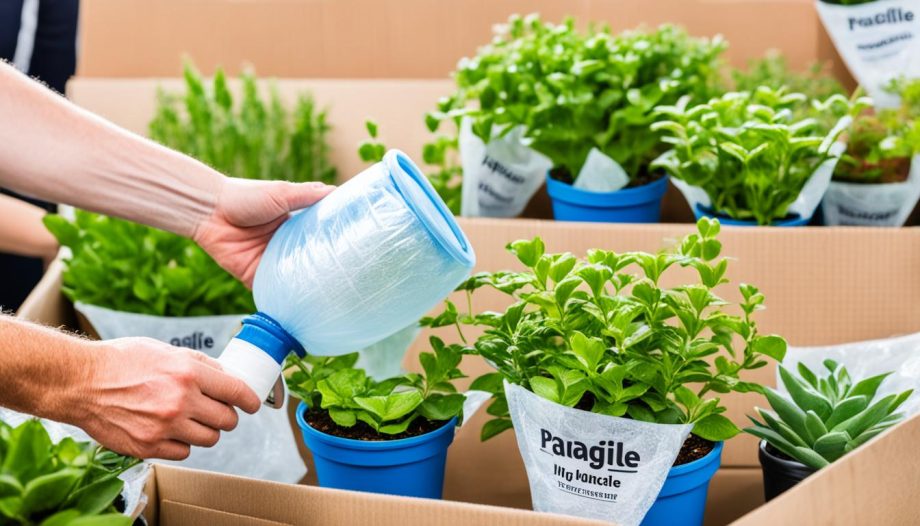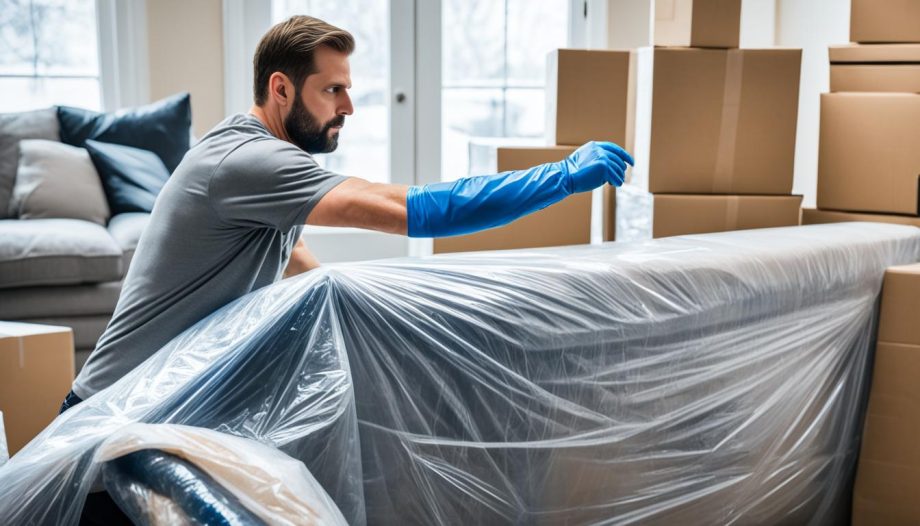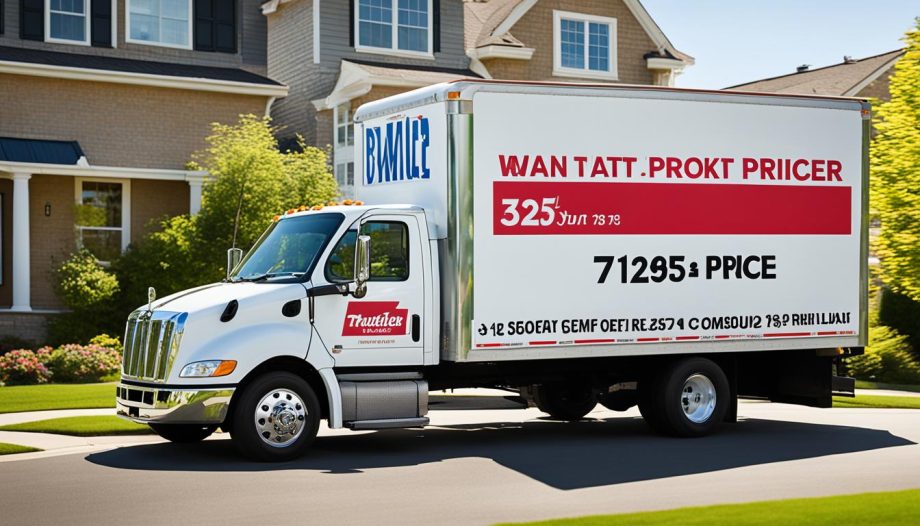Moving can be a stressful experience, especially when it comes to transporting your beloved plants. You want to ensure that they arrive safely and continue to thrive in their new environment. That’s where our stress-free guide to packing plants for moving comes in.
With our expert tips and advice, you can efficiently and safely pack your plants, giving them the best chance to flourish in their new home. Whether you have delicate indoor plants, potted greenery, or a garden full of outdoor plants, we have you covered.
Our step-by-step guide will walk you through choosing the right packing materials, preparing your plants for the move, and securely packaging them to prevent damage. We’ll also provide tips for acclimating your plants to their new environment and caring for them after the move.
Additionally, we’ll address any legal considerations that may arise when moving plants, such as permits or regulations. And if you’re considering hiring professional plant movers, we’ll offer tips on finding reputable movers who specialize in handling delicate plants.
Whether you’re moving your plants long distance or overseas, we’ll provide insights and logistics to ensure a successful and smooth transition for your beloved greenery.
Throughout this guide, our goal is to help you maintain the beauty of your plants and keep your garden intact during the moving process. Let’s embark on this exciting journey together and ensure that your plants thrive in their new environment.
Choosing the Right Packing Materials
Before you start packing your plants for the move, it’s crucial to choose the right packing materials. The right materials will ensure the safety and security of your plants throughout the relocation process. Let’s explore the different options available and provide recommendations for packing materials that are suitable for packing plants.
When it comes to packing materials for plants, there are several factors to consider, including protecting the delicate foliage and roots. Here are some options to consider:
- Plant Boxes: Use sturdy plant boxes designed specifically for transporting plants. These boxes are usually made of durable cardboard and have handles for easy carrying. They come in various sizes to accommodate different plant sizes.
- Plant Sleeves: For smaller plants, consider using plant sleeves. These plastic sleeves provide extra protection and prevent soil spillage during transportation.
- Packing Paper: Wrap each plant in packing paper to protect the foliage from getting damaged. Avoid using newspaper as it may contain ink that can transfer to the leaves.
- Bubble Wrap: For extra protection, wrap delicate plants or plants with protruding leaves in bubble wrap. This will provide cushioning and prevent any damage during transit.
- Packing Peanuts: Use packing peanuts to fill any empty spaces in the box. This will secure the plants in place and prevent them from shifting during transportation.
Tip: Consider labeling each box with the name of the plant or a brief description to easily identify them during the unpacking process.
Now that you know the different packing materials available, you can choose the ones that best suit your plants’ needs. Remember to pack plants of similar sizes together and avoid overcrowding the boxes to prevent damage.
| Packing Materials | Features |
|---|---|
| Plant Boxes | Durable, designed for transporting plants, various sizes available |
| Plant Sleeves | Plastic sleeves, suitable for smaller plants, prevents soil spillage |
| Packing Paper | Wraps plants, protects foliage, prevents ink transfer |
| Bubble Wrap | Provides extra protection, cushions delicate plants |
| Packing Peanuts | Fills empty spaces, secures plants in place, prevents shifting |
Remember, the right packing materials can make all the difference in ensuring that your plants arrive at their new location in good condition. With proper packing and the use of suitable materials, you can make the moving process stress-free for both you and your green companions.
Preparing Plants for Packing
Properly preparing your plants for packing is crucial to their survival during the move. Whether you have potted plants, larger indoor plants, or outdoor plants, taking the time to prepare them will help minimize shock and stress during the transition. Follow these tips to ensure your plants arrive at their new home in the best possible condition.
Potted Plants
For potted plants, start by trimming any dead or damaged leaves and branches. This will help the plant conserve energy during the move. Next, gently remove the plant from its pot, being careful not to damage the roots. If necessary, loosen up the root ball and remove any excess soil.
Place the plant in a plastic bag or wrap the roots in damp newspaper to keep them moist during the move. Secure the bag or newspaper with a rubber band or twine. It’s important to keep the roots protected and hydrated throughout the journey.
If you have larger potted plants that cannot fit in a bag, consider wrapping the entire plant in burlap or plastic wrap. This will help prevent damage to the foliage and branches.
Indoor Plants
Preparing larger indoor plants for packing requires a bit more effort. Start by pruning any excess growth to make the plant more compact and easier to transport. If the plant has long, trailing branches, consider using twine or plant ties to secure them to the main stem.
If your indoor plant is in a decorative pot without drainage holes, transfer it to a plastic nursery pot a few weeks before the move. This will make it easier to water the plant without causing leaks during transportation.
Water your indoor plants a day or two before the move to ensure they’re properly hydrated. Avoid overwatering, as excess moisture can lead to root rot.
Outdoor Plants
When preparing outdoor plants for packing, start by trimming any dead or diseased branches. This will help promote healthy growth and prevent the spread of pests or diseases to your new location.
If you have delicate plants or those with sensitive foliage, consider constructing a protective cage using chicken wire or stakes and burlap. This will shield the plant from wind and prevent damage during transit.
Water your outdoor plants thoroughly a day or two before the move to ensure they’re hydrated. If you’re moving during the hot summer months, providing shade during the journey can help prevent stress and sunburn.
Remember to label each plant with its corresponding name to avoid confusion when unpacking. Keep the plants in a well-ventilated area during transportation, away from extreme temperatures or direct sunlight.
| Plant Type | Preparation Steps |
|---|---|
| Potted Plants | Trim dead leaves and branches, wrap roots in plastic bag or damp newspaper |
| Indoor Plants | Prune excess growth, secure trailing branches, transfer to plastic nursery pot if needed |
| Outdoor Plants | Trim dead or diseased branches, construct protective cage if necessary, water thoroughly |
By following these preparation steps, you can ensure that your plants are ready for the packing process and well-protected during the move. Remember to handle each plant with care and unpack them as soon as possible upon arrival at your new home.
Packing and Securing Plants
Now that you’ve chosen the right packing materials and prepared your plants, it’s time to pack and secure them for the move. Proper packing and securing techniques are essential to ensure your plants remain safe and undamaged during transportation. In this section, we will guide you through the process step by step, providing expert tips and advice for a successful move.
1. Wrapping Individual Plants
Before packing your plants into boxes, it’s important to wrap them properly to protect their delicate foliage and prevent any damage during transit. Start by gently wrapping the plant in a soft material such as newspaper, tissue paper, or burlap. Secure the wrapping with twine or rubber bands, ensuring it is snug but not too tight. This will help to keep the foliage in place and protect it from getting damaged while in transit.
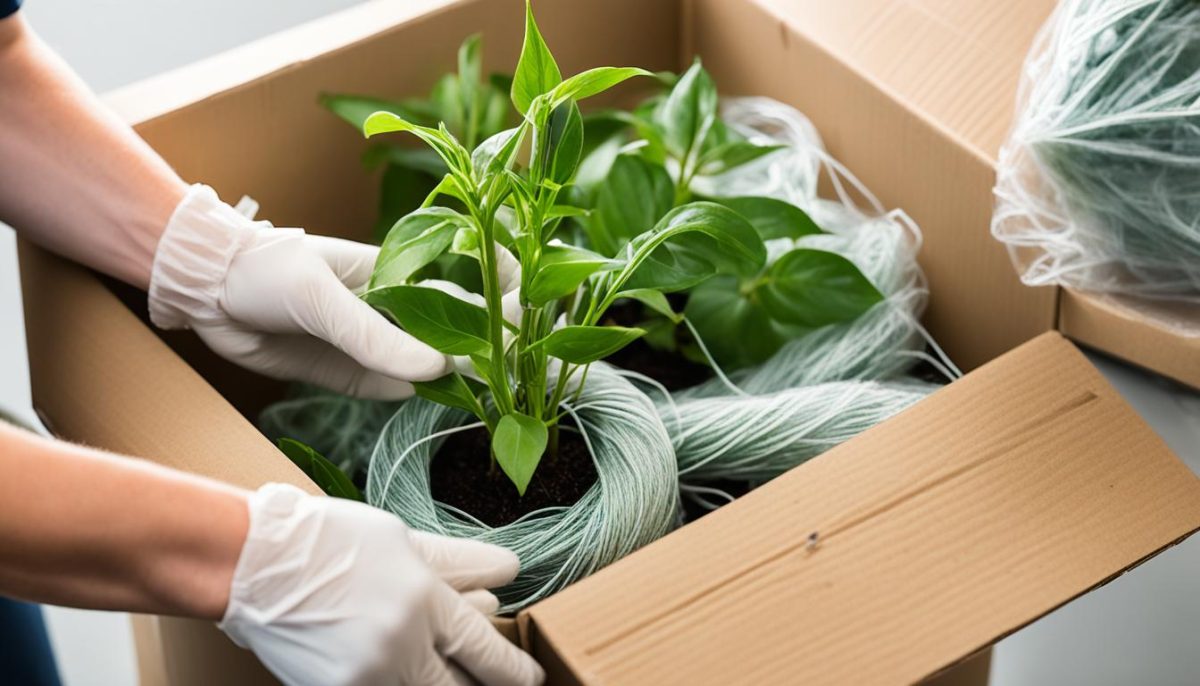
2. Packing Plants in Boxes
When it comes to packing plants in boxes, it’s essential to choose the right size and type of box. Opt for sturdy cardboard boxes that can provide proper support and protection. Before placing the plants in the boxes, line them with plastic bags or old towels to prevent soil spillage. Carefully place each wrapped plant into its designated box, ensuring there is enough space for the roots and foliage to fit comfortably. Fill any gaps with packing peanuts or crumpled paper to prevent shifting during the move.
3. Securing the Boxes
Once your plants are securely packed in boxes, it’s crucial to ensure they are properly sealed to prevent any accidental opening during transportation. Use strong packing tape to seal all edges of the boxes, reinforcing corners and seams. Label the boxes clearly as “Fragile” and “This Side Up” to alert movers to handle them with care.
Pro Tip: If you have particularly fragile plants or those with sensitive foliage, consider placing them in separate boxes or providing additional cushioning.
4. Considerations for Fragile Plants
If you have fragile plants such as orchids or succulents, extra precautions are necessary to keep them secure. Consider using specialty plant boxes with adjustable inserts to hold individual pots or investing in plant shipping kits that provide extra support. These kits often include foam inserts and dividers that keep the plants stable and prevent any movement or damage.
Remember to pack any necessary tools or materials separately, such as stakes, ties, or plant food, to ensure you have everything you need to care for your plants once they arrive at your new home.
| Packing and Securing Plants Checklist |
|---|
| Choose sturdy cardboard boxes of the appropriate size |
| Wrap individual plants using soft materials |
| Line the boxes with plastic bags or towels to prevent soil spillage |
| Fill gaps in boxes with packing peanuts or crumpled paper |
| Secure boxes with strong packing tape |
| Label boxes as “Fragile” and “This Side Up” |
| Consider specialty plant boxes or shipping kits for fragile plants |
By following these packing and securing techniques, you can ensure that your plants are well-protected and arrive at their new destination in optimal condition. The next section will cover the essential steps for nurturing your plants after the move.
Nurturing Plants After the Move
Once you’ve successfully moved your plants to their new location, it’s time to provide them with the nurturing care they need to thrive in their new environment. By following these essential tips, you can ensure that your plants continue to flourish and adapt to their new home.
Acclimate Your Plants
Plants can experience shock when transitioning to a new environment. To help them adjust, gradually introduce them to their new surroundings. Start by placing them in a shaded area for a few days and gradually increase their exposure to sunlight. This gradual acclimation will help prevent stress and promote healthy growth.
Provide the Right Amount of Sunlight
Each plant has specific sunlight requirements. Take the time to research the optimal sunlight levels for each of your plants and position them accordingly. Some plants thrive in direct sunlight, while others prefer more shade. By providing the right amount of sunlight, you’ll give your plants the best chance of flourishing after the move.
Watering Routine
Watering is crucial for the well-being of your plants, especially during the adjustment period. Monitor the moisture levels of the soil and water your plants accordingly. Be cautious not to overwater, as this can lead to root rot. On the other hand, underwatering can cause stress and dehydration. Find the right balance and ensure that your plants receive adequate hydration.
Monitor for Stress and Damage
During the first few weeks after the move, closely observe your plants for any signs of stress or damage. Look for wilting leaves, yellowing, or browning foliage. Pests and diseases can also become an issue during this time. Address any issues promptly to prevent further damage and support the health of your plants.
Patience is Key
Remember, plants need time to settle into their new environment and adjust to the changes. Be patient and give them the necessary care and attention. With time, your plants will adapt and thrive in their new home, bringing life and beauty to your living space.
Nurturing your plants after the move is crucial for their long-term health and well-being. By following these tips, you can create a nurturing environment that allows your plants to flourish and continue to bring beauty and joy to your home.
Legal Considerations for Moving Plants
When you’re planning to move your beloved plants to a new location, there are some legal considerations you should keep in mind. These legal regulations and restrictions aim to protect the environment and prevent the spread of pests and diseases. It’s essential to understand and comply with these guidelines to ensure a smooth and compliant move for your plants.
Depending on your moving destination, there may be permits or regulations in place for transporting plants, especially when relocating across state or international borders. Some states or countries have specific requirements for bringing in plants to prevent the introduction of invasive species or potential threats to local ecosystems.
To ensure legal compliance when moving plants, here are a few steps you can take:
- Research local regulations: Before you start planning your move, research the specific requirements and regulations of your destination regarding plant transportation. Check with your local agricultural or plant health authority, as well as the government or customs agency of your new location.
- Obtain necessary permits: Depending on the regulations, you may need to obtain permits or certifications to transport certain types of plants. These permits ensure that you are complying with the legal requirements and can help prevent any issues during transit.
- Check for quarantine restrictions: Some destinations have quarantine periods for certain types of plants. Make sure to be aware of any quarantine restrictions and follow the necessary procedures to ensure your plants meet the requirements before and after the move.
- Know prohibited plants: Familiarize yourself with the plant species that are prohibited for import or export in your destination. Certain plants may be listed as invasive or may pose a threat to the local environment, and transporting them could be against the law.
Quote
“Understanding and complying with the legal considerations involved in moving plants is crucial to protect both the environment and your plants’ health. By following the regulations and obtaining the necessary permits, you can ensure a successful and lawful move for your green companions.”
By keeping these legal considerations in mind and taking the necessary steps to comply with regulations, you can have peace of mind knowing that your plant relocation is both legal and environmentally responsible.
Next, we will discuss some important tips for hiring professional plant movers, ensuring that your plants are handled with care and expertise during the move.
Tips for Hiring Professional Plant Movers
If you have a large collection of plants or particularly valuable specimens, it’s essential to enlist the help of professional plant movers to ensure a safe and efficient relocation. Hiring experts in this field will provide you with peace of mind and guarantee that your beloved plants arrive at their new home in optimal condition. Here are some tips to consider when hiring professional plant movers:
- Research reputable plant movers: Begin by conducting thorough research to identify reputable plant moving companies in your area. Look for specialized movers who have expertise in handling delicate plants and have a proven track record of successful plant relocations.
- Check for proper licensing and insurance: It’s crucial to verify that the plant movers you’re considering are fully licensed and insured. This will protect you in the event of any damage or accidents during the move.
- Ask for references: Request references from past clients who have used the services of the plant movers you’re considering. Reach out to these references to inquire about their experience and level of satisfaction with the moving company.
- Get multiple quotes: Obtain quotes from several reputable plant moving companies to compare prices and services. Keep in mind that the lowest price doesn’t always guarantee the best service, so consider the overall reputation and experience of the movers as well.
- Discuss specialized plant care: During the consultation with the plant movers, discuss any specific requirements or concerns you may have regarding the care and transportation of your plants. Professional movers should be able to provide tailored solutions and address your unique needs.
By following these tips, you can ensure that you hire professional plant movers who understand the importance of proper handling and transportation. With their expertise, you can relax knowing that your plants are in capable hands.
Testimonials
“I recently used the services of Green Thumb Plant Movers, and I couldn’t be happier with the results! They handled my extensive plant collection with care and professionalism. Highly recommended!”
– Jane Smith, Plant Enthusiast
“Plant Pros Moving Company made the entire process of relocating my plants stress-free and easy. Their attention to detail and knowledge of plant care were impressive. I would definitely use their services again!”
– Michael Johnson, Plant Collector
Comparison of Professional Plant Movers
| Plant Mover | Services Offered | Price Range | References |
|---|---|---|---|
| Green Thumb Plant Movers | Specialized plant care, packaging, transportation, unpacking | $$$ | Available upon request |
| Plant Pros Moving Company | Customized plant relocation plans, packing materials, transportation | $$ | Positive client testimonials |
| Blooming Gardens Plant Movers | Plant packing, crating, trucking, plant set-up | $$$ | Verified customer reviews |
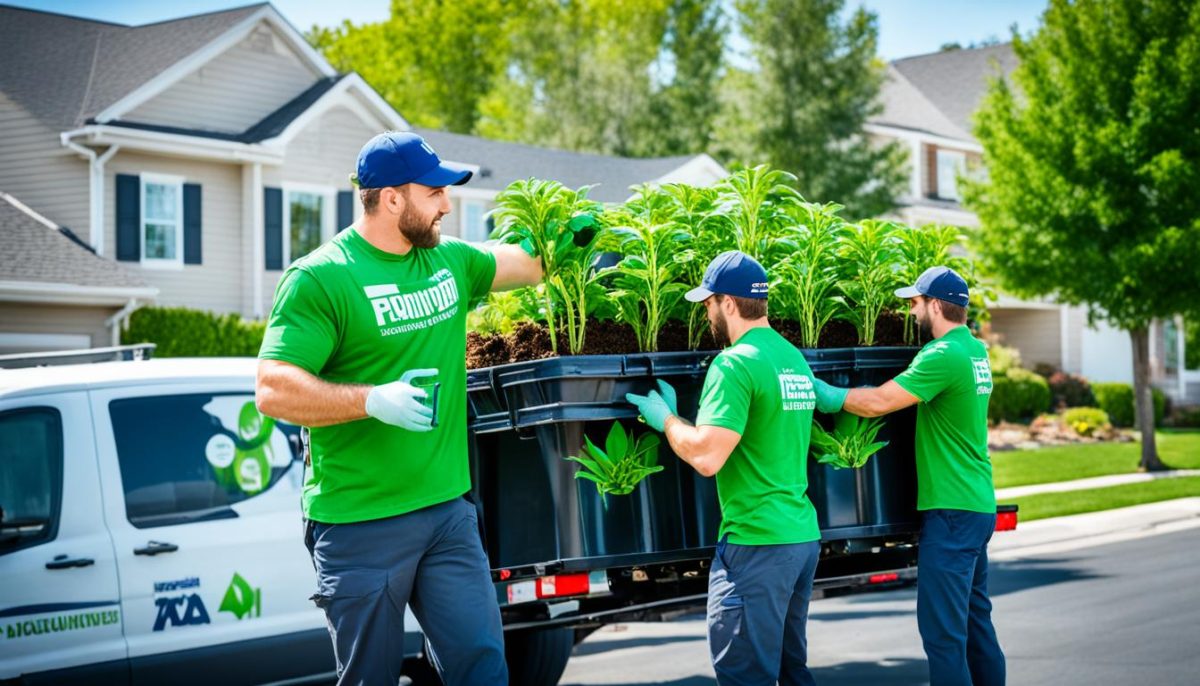
Garden and Outdoor Plant Moving Tips
Transplanting your garden or outdoor plants can be a complex process that requires careful planning and preparation. In this section, we will provide you with specific tips to ensure a smooth and successful move for your beloved greenery. From preparing the soil to protecting your plants from extreme weather conditions, we’ve got you covered.
Preparing the Soil
Before attempting to move your garden plants, it’s essential to prepare the soil to minimize stress and promote healthy growth in their new location. Follow these steps:
- Water your plants thoroughly a day or two before the move to ensure they’re well-hydrated.
- Loosen the soil around the plants using a garden fork or shovel, being careful not to damage the roots.
- Remove any weeds or debris from the soil to prevent unwanted pests from hitching a ride.
- If necessary, amend the soil with organic matter to provide the plants with essential nutrients for their transition.
Digging Up and Packaging Root Balls
Properly digging up and packaging the root balls of your garden plants is crucial for their survival during transport. Follow these guidelines:
- Choose an appropriate time to dig up the plants, preferably during their dormant period to minimize shock.
- Start by digging a wide circle around the plant, ensuring that you include the majority of the root ball.
- Gently lift the plant out of the ground, taking care not to damage the roots.
- Wrap the root ball in burlap or moist newspaper to retain moisture and protect the roots.
- Secure the wrapping with twine or rubber bands to prevent it from coming loose during transportation.
Transporting Plants Safely
The journey from your old garden to your new location can be stressful for your plants, so it’s essential to take precautions to ensure their safety. Consider the following:
“During transport, place your plants in sturdy, well-ventilated containers that allow for proper airflow. Make sure the containers are secured in your vehicle to prevent them from tipping over or sliding during the move.” – Gardening Experts
Winterizing Plants and Protecting Them from Extreme Weather
If you’re moving your garden plants during the winter months or in extreme weather conditions, it’s crucial to take extra measures to protect them from the cold or heat. Here’s what you can do:
- Wrap sensitive plants in burlap or frost blankets to provide insulation against the cold.
- Water your plants adequately before the move to help protect their root systems from freezing.
- If moving during a heatwave, shield your plants from direct sunlight and consider misting them with water to keep them cool.
- Ensure proper ventilation during transport to prevent excess heat buildup.
By following these garden and outdoor plant moving tips, you can ensure that your greenery is well-prepared for the journey ahead. Remember to monitor your plants closely after the move and provide them with the necessary care to help them thrive in their new environment.
Moving Plants Long Distance or Overseas
Moving plants long distance or overseas can be a daunting task, but with proper planning and preparation, you can ensure a successful relocation for your green companions. In this section, we will explore the considerations and logistics involved in moving your beloved plants to a different state or across international borders.
One of the crucial factors to consider when moving plants long distance or overseas is customs regulations. Different countries and states have varying rules and restrictions when it comes to importing plants. It’s essential to research and familiarize yourself with the destination’s regulations to avoid any legal issues or delays. Some countries require permits or phytosanitary certificates to ensure that the plants are pest-free and meet their biosecurity standards.
Additionally, quarantine procedures may be necessary when moving plants overseas. It’s crucial to understand the specific quarantine requirements of the destination country to prevent the introduction of pests or diseases. Be prepared to follow any necessary procedures, such as providing documentation or allowing inspections, to ensure a smooth entry for your plants.
The transportation method is another vital consideration when moving plants long distance or overseas. Depending on the distance and duration of the journey, you may choose to transport your plants by road, air, or sea. Each mode of transport has its own challenges and requirements, so it’s important to select the most suitable option for the well-being of your plants.
Tips for moving plants long distance or overseas:
- Research customs regulations and permit requirements for the destination.
- Understand quarantine procedures and comply with them as necessary.
- Choose the most appropriate transportation method for your plants’ well-being.
- Package your plants securely, providing ample protection for their foliage and roots.
- Consider using specialized plant shipping services for overseas moves.
Remember, moving plants long distance or overseas requires diligent planning and attention to detail. By following the tips and guidelines provided in this section, you can ensure a smooth and successful move for your beloved plants, allowing them to thrive in their new environment.
Plants That Cannot Be Moved
While most plants can be successfully moved, there are certain types that are difficult or impossible to relocate. It’s important to be aware of these plants before you begin the moving process to avoid any disappointment or frustration.
Difficult-to-Relocate Plants
Some plants have extensive root systems or delicate foliage that make them challenging to move. These include:
- Mature Trees: Large trees with well-established root systems are nearly impossible to transplant due to their size and the disruption it causes to their root structure.
- Giant Bamboo: This fast-growing and invasive species has root systems that can spread over a large area, making it difficult to contain and transport.
- Cacti and Succulents: The delicate nature of these plants can make it challenging to transport them safely without damaging their spines or leaves.
- Orchids: Orchids have sensitive root systems and can be challenging to repot, making them difficult to move without causing stress or damage.
Alternatives for Preserving Their Presence
If you have plants that cannot be moved, there are alternative ways to preserve their presence in your new home:
- Take Cuttings: You can take cuttings from the plants and propagate them in your new location. This allows you to maintain the lineage of the plant while leaving the original behind.
- Gift or Donate: Consider giving the plants to friends, family, or local organizations that can provide them with a suitable environment. This ensures the plants continue to thrive and bring joy to others.
- Sell or Trade: If the plants hold significant value or are rare specimens, you may choose to sell or trade them with other plant enthusiasts. This way, you can ensure they go to a new home where they will be appreciated.
Remember, plants are living organisms that require specific care and conditions to thrive. If you’re unsure about the feasibility of moving a particular plant, it’s always best to consult with a professional gardener or horticulturist who can provide you with expert guidance.
By understanding which plants can and cannot be moved, you can make informed decisions about how to approach your move. Whether you find alternatives for preserving their presence or say goodbye to certain plants, the goal is to ensure a smooth and successful transition for both you and your green friends.
Conclusion
In conclusion, successfully moving your plants to a new location requires careful preparation and attention. By following the tips and guidelines provided in this guide, you can ensure the safe and healthy relocation of your greenery.
Remember to pack your plants properly using the recommended materials, while protecting their delicate foliage and roots. Take the time to prepare each plant according to its specific needs and minimize stress during the transition.
After the move, nurture your plants by acclimating them to their new environment and providing the right amount of sunlight and water. Keep a close eye on their condition and address any signs of stress or damage promptly.
By following these steps, you can maintain the beauty of your plants and ensure that your garden remains intact throughout the moving process. With a little patience and care, your plants will thrive in their new surroundings, bringing life and greenery to your new home.

